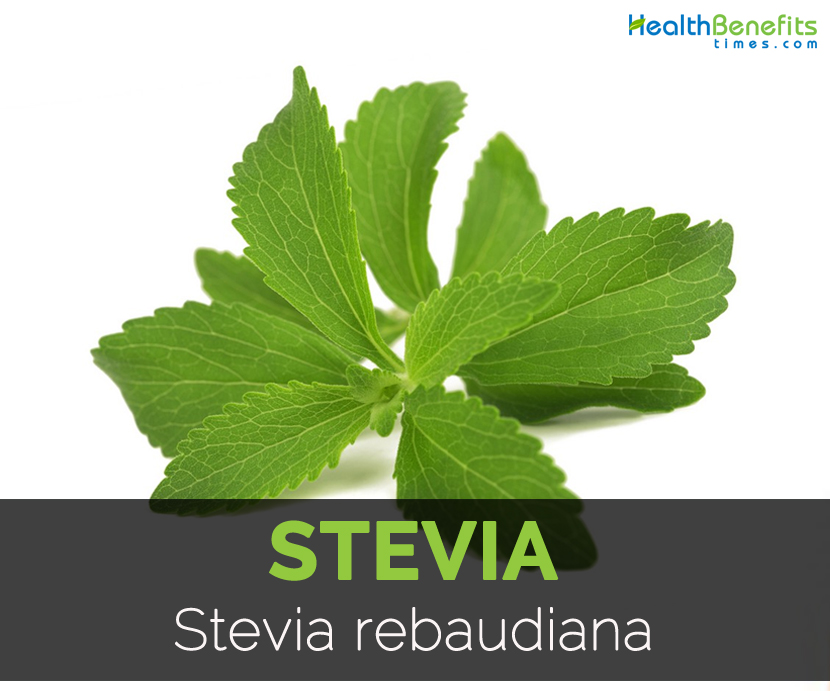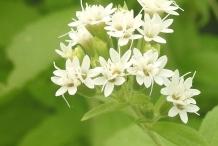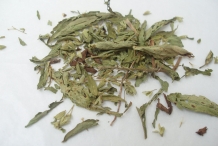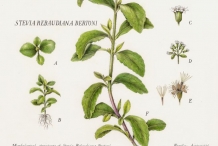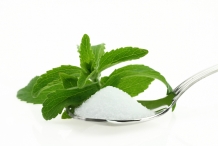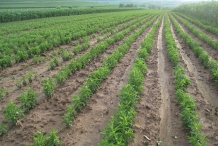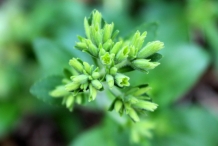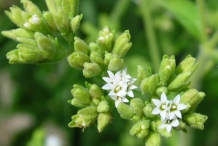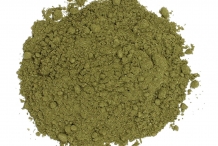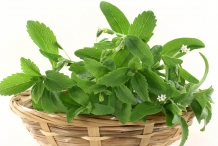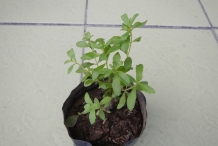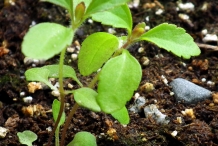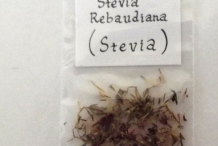| Stevia Quick Facts |
| Name: |
Stevia |
| Scientific Name: |
Stevia rebaudiana |
| Origin |
Native to northeastern Paraguay and adjacent Brazil and Argentina |
| Taste |
Sweet |
| Major nutrients |
Carbohydrate (76.92%) |
| Health benefits |
Oral care, Healthy skin, Stronger bones, Supports Weight Loss, Keep Cholesterol in Check |
Stevia scientifically called Stevia rebaudiana is a perennial and herbaceous shrub belonging to Asteraceae family. In Asteraceae family, there are more than 240 species of shrubs as well as small flowering plants. This family also includes daisy and ragweed. Stevia is known from various names such as sugar leaf and sweet leaf. Native to Northeastern Paraguay, Brazil and Argentina, it is widely cultivated as a source of sweet glycoside compounds that is derived from leaves. It is an alternative low calorie sweetener which is hundred times sweeter in comparison to sucrose. Stevia possess eight glycosides which includes stevioside, rebaudiosides A, C, D, E, and F, steviolbioside dulcoside A. Rebaudioside and stevioside are active compounds in Stevia glycosides which provide sweetness.
Japan, Taiwan, China, Thailand, Brazil, Korea, Malaysia and Paraguay are the main producers of Stevia. It is a green leafy herbal plant which has been used for hundreds of years for its sweet leaves. It got fame as an artificial sweetener which provides more than 40 times sweetness than sugar without affecting the levels of blood sugar. It does not provide any side effects on body like normal sugar do and is helpful for diabetic patients.
History and use
Stevia plant has been used by the Guaraní people of Brazil and Paraguay for more than 1500 years as ka’a he’ê which means sweet herb used to sweeten local yerba mate tea and is also used as medicine and sweet treat.
Botanist Moisés Santiago Bertoni in 1899 described the plant being grown in eastern Paraguay, and noticed its sweet taste.
Chemists R. Lavielle and M. Bridel confined the glycosides stevioside and rebaudioside in 1931 which provides sweet taste to leaves. In 1955, an exact structure of glycoside and alycone was published.
Plant
Stevia rebaudiana is an evergreen shrub belonging to family Compositae. The plant measures upto 9 meters with erect, floppy and pubescent stems. Stems are 12 to 24 inches tall. The dark green leaves are simple, alternate, toothed, lanceolate or elliptic and measures about 5 cm long. The plant bears white and tube shaped flowers forming in panicles. Flowers are fragrant and tubular.
Types of Stevia
Stevia can be found in three forms that depend on the level of processing:
- Green Leaf Stevia: It is the least processed form which is 30 to 40 times sweeter in comparison to sugar. It is also slightly bitter to taste.
- Stevia Extracts: It is 200 times sweeter in comparison to sugar and is less bitter to green leaf stevia.
- Altered Stevia: It is a highly processed form of stevia which possess GMO ingredients. If compared to the sugar, it is 200 to 400 times sweeter than sugar. It is also termed as worst form of stevia.
Health Benefits of Stevia
Here are some health benefits offered by Stevia:
- Oral care
Stevia helps to lower formation of bacteria in mouth and is a popular additive for mouthwashes and toothpastes. It also prevents the chances of gingivitis and cavities.
- Healthy skin
Stevia is helpful for skin problems such as dermatitis and eczema. Apply it topically to prevent growth and spread of bacteria. It acts as a steroid.
- Stronger bones
Stevia helps to promote mineral density of bones and treat osteoporosis. The study conducted on animals shows the necessity in increased calcium metabolism.
Click here to know more Health Benefits of Stevia
https://www.youtube.com/watch?v=t8Ev6l_8s18
Precautions
- People who are allergic to ragweed, daisies and marigolds might get allergic reactions.
- It can cause side effects such as nausea, bloating, numbness, dizziness and muscle pain.
- Some signs of oral allergic reactions are itching and swelling of lips, tongue, throat, mouth, nausea, abdominal pain, tingling sensation in mouth & throat and vomiting. Seek for medical attention if these symptoms are experienced.
- Pregnant and breastfeeding women should use it with caution.
- People having ongoing medical condition or with medications should consult doctor before using stevia.
- Low blood sugar and diabetic patients should monitor level of blood sugar and blood pressure respectively after consumption of stevia.
How to Eat
- Stevia is used to sweeten beverages and also to make tea.
- It is used in desserts, ice cream, yogurts, sauces, bread, pickled foods, chewing gum, soft drinks, seafood, candy and prepared vegetables.
- Stevia extracts are used as table sugar.
- Dried leaves could be grounded and used as a sweetener.
- Add powdered leaves to the teas.
References:
https://www.livescience.com/39601-stevia-facts-safety.html
https://draxe.com/stevia/
https://www.medicalnewstoday.com/articles/287251.php
https://www.nutrition-and-you.com/stevia-plant.html
https://www.itis.gov/servlet/SingleRpt/SingleRpt?search_topic=TSN&search_value=505914#null
https://www.pfaf.org/user/Plant.aspx?LatinName=Stevia+rebaudiana
https://www.medicinenet.com/stevia/supplements-vitamins.htm
https://www.organicfacts.net/health-benefits/other/stevia.html
https://www.botanical-online.com/english/stevia-plant.htm
http://www.missouribotanicalgarden.org/PlantFinder/PlantFinderDetails.aspx?kempercode=e489
Comments
comments


